INTRODUCTION
Bony vault deviation is frequently found in deviated noses. Proper management of the nasal bony vault is an integral part of rhinoplasty for a deviated nose, as well as for reducing the dorsal profile line or narrowing the width of the bony base. Conventional osteotomies to correct a deviated nose are composed of medial and lateral osteotomies, which allow the deviated bony lateral walls to be mobilized. Such osteotomies may mobilize the nasal lateral walls, but the central structures of the bony vault, including the septum (a medial strip of nasal bones) and the interposed nasal spine of the frontal bone, remain deviated, which can cause incomplete correction or recurrence of deviated nose [
1].
To address this problem, many surgeons have performed root or transverse osteotomy with medial and lateral osteotomies [
2,
3]. However, these combined techniques often make it difficult to control each segment, and the connection to adjacent bony support can become unstable. In particular, Asians tend to have short nasal bones with a flatter dorsum, which can make osteotomy more difficult [
4]. In patients with narrow and short nasal bones, there is a higher likelihood of damage to the keystone area during medial osteotomy or unstable fixation of the bony segment after transverse osteotomy.
In an effort to preserve the keystone area, dorsal preservation techniques have been introduced in reduction rhinoplasty [
5]. This technique preserves the dorsal osseocartilaginous vault without manipulating the keystone area, and we were inspired to apply this technique to a crooked nose via a unilateral let-down operation. Therefore, we introduce a new technique to correct a centrally deviated bony dorsum in the present study. This new technique, one-unit osteotomy, combines bilateral lateral and root osteotomies with unilateral triangular bony wedge resection of a longer sidewall to ensure symmetry of both nasal bones and better structural integrity.
Go to :

RESULTS
The mean age was 33.4±15.6 years (range, 17–60 years), and 15 patients were men (75%) in the one-unit osteotomy group. Nineteen patients were East Asians, and one patient was Caucasian (one man). The postoperative results were evaluated using the NOSE scale and postoperative photographs, and the postoperative evaluation was performed approximately 3 months on average after surgery (
Table 1). Three revision rhinoplasty cases were included in this study.
Table 1.
Baseline characteristics and preoperative and postoperative results of septorhinoplasty with one-unit osteotomy
|
Variable |
Preoperative |
Postoperative |
P-value |
|
Number of patients |
20 |
- |
|
Age (yr) |
33.4±15.6 (17–60) |
- |
|
Male |
15 (75) |
- |
|
NOSE scale |
8.4±6.4 |
4.1±4.2 |
0.021 |
|
Bony deviation angle (°) |
6.9±2.2 |
2.1±1.2 |
<0.001 |
|
Grade of remaining deviation |
- |
1.6±0.5 |
|

Regarding subjective symptoms after one-unit osteotomy, NOSE values improved from 8.4±6.4 to 4.1±4.2 (
P =0.021). When one-unit osteotomy was performed, the bony vault deviation angle improved from 6.9°±2.2° to 2.1°±1.2° (
P <0.001). The postoperative values of one-unit osteotomy were close to the ideal angles. Even with conventional osteotomy, a significant improvement was observed, from 7.3°±4.0° to 2.7°±1.2° (
P = 0.001). There was no significant difference in the postoperative deviation angle between the two groups (
P =0.158). However, the percentage of angle improvement relative to the preoperative deviation angle ([preoperative deviation angle−postoperative deviation angle]/preoperative deviation angle×100) was 70.3% in one-unit osteotomy compared with 56.6% in conventional osteotomy (
P =0.033), indicating a greater relative improvement in one-unit osteotomy (
Fig. 6).
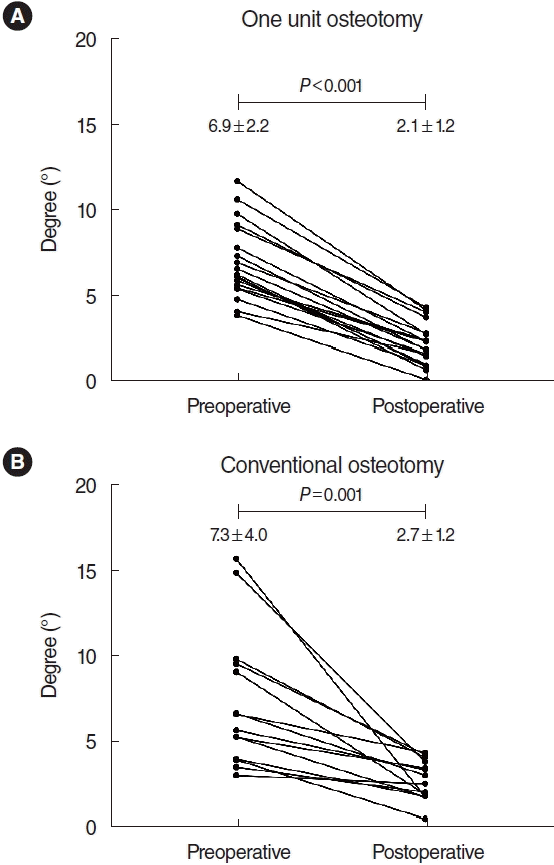 | Fig. 6.Changes in the bony vault deviation angle. (A) One-unit osteotomy group. The deviation angle improved from 6.9°±2.2° to 2.1°±1.2° (P<0.001). (B) Conventional osteotomy group. The deviation angle improved from 7.3°±4.0° to 2.7°±1.2° (P=0.001). There was no significant difference in the postoperative deviation angle between the two groups (P=0.158). However, the relative improvement compared to the preoperative angle (Δdeviation angle/preoperative angle×100) was 70.3% for one-unit osteotomy, which was better than that achieved using conventional osteotomy (56.6%, P=0.033). 
|
Three independent physicians evaluated the esthetic outcomes for each patient using the final results, as follows: complete correction (grade 1), minimally visible deviation (grade 2) or remaining residual deviation (grade 3). The mean grade of postoperative residual deviation after one-unit osteotomy was 1.6±0.5. Sixteen patients (80%) received grades 1 and 2 from all raters, and the remaining four patients (20%) received grade 3 from at least one rater. In the conventional osteotomy group, the mean grade of the esthetic outcome was 1.7±0.4, and three patients (21.4%) received grade 3 from at least one evaluator. No significant difference was found in the mean grade (P =0.80) or the proportion of the remaining residual deviation (P =1.00) between the two groups.
There were no significant complications, including inverted-V deformity, open-roof deformity, or bleeding, after one-unit osteotomy. Only one patient with preoperative supratip saddle deformity, which was addressed with diced cartilage and Surgicel (Ethicon), complained about the postoperative recurrence of saddle nose.
Go to :

DISCUSSION
We introduced one-unit osteotomy, which addresses a centrally deviated bony vault and combines bilateral lateral and root osteotomies with unilateral triangular bony wedge resection of a wider sidewall to ensure the symmetry of both nasal bones. This new technique improved functional outcomes and led to non-inferior esthetic results compared to the conventional procedure, and there was no significant postoperative complication. Bony vault deviation improved in all patients. In addition, the subjective nasal obstruction symptom also improved after surgery. The main purpose of this procedure is to balance the width of both lateral walls and preserve structural integrity. Asymmetry of the bony lateral wall in the deviated bony vault is accompanied by widening and lengthening of one side of the bony vault; in our new technique, triangular resection of the upper lateral cartilage is performed to address the middle vault deviation [
8]. Therefore, this one-unit osteotomy technique might be essential if the size of the bony lateral wall is dissimilar. Moreover, as an added advantage, this technique preserves the structural integrity of the bony vault by avoiding medial osteotomy, thereby enabling postoperative self-readjustment. Additionally, no columellar incision intended for medial osteotomy is required if the rest of the procedure is possible with an endonasal approach.
One of the greatest challenges for rhinoplasty surgeons is fixing deviated noses. Although various trials have been conducted to evaluate methods of deviated nose correction, the degree of satisfaction after crooked nose surgery remains low [
11]. Some considerations should be kept in mind while planning surgery to fix a deviated nose. First, the problems associated with deviated noses are complex. The reasons for nasal deviation vary among patients, and multiple factors can be involved. Some patients have problems with bony vault and others with the upper lateral or lower lateral cartilage. Furthermore, septal deviation is involved in most patients with deviated noses. In recent years, the importance of facial asymmetry has also been emphasized for deviated nose correction. Objectively, 97% of patients were found to have significant degrees of facial asymmetry, with the midline to ala distances showing the most variations, and patients with deviated noses had a higher likelihood of facial asymmetry [
12,
13]. Owing to the complexity of the problem, deviated noses require a wide range of delicate and sophisticated surgical techniques to obtain better results for both surgeons and patients [
14].
To address a deviated bony vault, the conventional technique favors simultaneous medial and lateral osteotomies and has been considered an effective way to correct a severely deviated nose. These osteotomies allow free independent movement of each nasal bone, which enables correction of the bony vault deviation. However, as many surgeons have mentioned, the results of this technique are often unsatisfactory. One of the causes of unsatisfactory results is that conventional osteotomy has a limitation in midline correction of the bony nasal root. Transverse or root osteotomy is required to fix the deviated nasal mid-root [
2]. Therefore, many surgeons have used a combination of medial, lateral, and transverse osteotomies. However, this combination technique has limitations in terms of fixing deviated noses. The first concern is that this combination technique produces multiple bone fragments, which leads to a loss of support and makes the bony vault less stable. The other concern is asymmetry of the nasal bony lateral walls in the deviated bony dorsum. For instance, when the bony dorsum is deviated to the right, the right bony wall is shorter and the left bony wall is longer. These asymmetric bony fragments after medial and lateral osteotomies are often the cause of unsatisfactory results or deviation recurrence. To overcome this instability arising from multiple bony segments, Choi et al. [
11] recommended a one-piece nasal bone osteotomy technique that combines transverse osteotomy with bilateral lateral osteotomies for the correction of a centrally deviated nose. In the aforementioned study, efficacy and satisfactory results were confirmed compared with conventional osteotomy. However, unlike our study, that procedure was not accompanied by unilateral bony wedge resection of the longer sidewall to balance the bilateral nasal bones, and septoplasty with the division of septal bone from the nasal dorsum was not performed simultaneously. In another study, to correct asymmetric bony segments after conventional osteotomy, some surgeons recommended asymmetric osteotomies according to the direction when correcting a deviated bony dorsum [
15].
Our one-unit osteotomy deals with the asymmetry of both bony walls by removing excessive bone on the wider side. A balanced lateral bony wall can reduce the recurrence of bony vault deviation after surgery. Furthermore, a unified mobile bony segment produced using this new technique can overcome the risk of instability around the keystone area and dorsal irregularity, which may be caused by multiple fragments in the conventional medial, lateral, and transverse osteotomy techniques. In addition, the nasal septum is a critical underlying support structure for the nose. The septum is responsible for providing stability to the dorsum, and septal deformity is frequently associated with a severely deviated nose [
16]. Inadequate correction of septal deviation, as well as improper osteotomy, may show unsatisfactory results in a crooked nose [
4]. In the present study, all patients had significant septal deviation, which was carefully addressed using various approaches, including our modified mattress suture technique for correcting septal high dorsal deviation around the keystone area [
6]. Through the “modified mattress suture” technique, the deviated PPE can be moved to the midline by a greenstick fracture at the subdorsal area, and the corrected PPE can be fixed and stabilized by suturing it with septal cartilage. This technique enables internal nasal valve modification by correcting high dorsal deviation leads to improved functional outcomes [
7]. In addition, a greenstick fracture was performed at the PPE below the dorsum, thereby enabling a fully mobilized nasal pyramid by dividing the residual bony septum from the nasal bone.
Compared with traditional osteotomy techniques, our new one-unit osteotomy procedure might produce a more stable and well-balanced new postoperative bony vault. In this study, when the outcomes of one-unit osteotomy and conventional osteotomy were compared, the bony vault deviation angle significantly improved in both groups, and there was no significant difference in the postoperative deviation angle; however, the one-unit osteotomy group was superior in terms of the relative improvement of the angle (expressed as a percentage).
As previously stated, this technique is influenced by the dorsal preservation hump removal technique. Dorsal preservation reduction rhinoplasty maintains the dorsum as one pyramid while lowering the hump, with or without resection of the lateral bony walls. It maintains structural integrity at the nasal keystone, patency of the internal nasal valve, and pleasing dorsal esthetic lines [
17]. Our new technique has the same advantage as the dorsal preservation hump technique. The difference between them is that our one-unit osteotomy does not remove the subdorsal septal strip to lower the hump; instead, it removes only excess bone fragments of the wider lateral bony wall. There was no complication of postoperative bony vault lowering associated with unilateral partial bony wall resection because the bony wall on the other side underwent osteotomy without bone removal, without being accompanied by subdorsal septal lowering. In addition, this technique preserves the dorsal osseocartilaginous vault since medial osteotomy is not simultaneously performed, so the stability of the keystone area can be expected. Regarding septoplasty, there was a concern about saddle nose as a result of performing wedge resection of the surplus septal cartilage at the bony-cartilaginous junction around the keystone and greenstick fracture of PPE in the subdorsal area. However, although mild saddle nose occasionally occurred intraoperatively, most of these cases were resolved after placing a modified mattress suture at the bony-cartilaginous junction to secure stabilization.
In this study, three independent otolaryngology surgeons graded the remaining deviation after one-unit osteotomy using postoperative photographs. Of the 20 patients who underwent one-unit osteotomy, four received grade 3 (remaining residual deviation) from at least one rater and three of them seemed to have more deviation due to facial asymmetry, which was difficult to evaluate. In the other patient, the surgical outcome was unsatisfactory because of bony fragments caused by a history of nasal bone fracture. If multiple bony fragments from previous trauma exist, it may be difficult to predict the surgical outcome because a completely unified bony segment may not be formed after one-unit osteotomy. Preoperative CT to check for a previous nasal bone fracture would be helpful for predicting surgical outcomes or selecting a surgical method.
The limitations of the present study include the short duration of follow-up and the use of various ancillary procedures to correct the middle vault and tip deviation. Deviation in the rhinion area is often accompanied by a crooked dorsal septum or upper lateral cartilage. Previously, we reported that the cartilaginous dorsum angle in the middle vault could be improved by endonasal septoplasty alone [
18]. In the severely deviated middle vault group, the improvement was more prominent, and the modified mattress suture technique was implemented to correct high septal deviation in more than half of those patients. In our opinion, correction of the dorsal septum may affect the external cartilaginous deviation of the rhinion area. However, in the present study as well, even after one-unit osteotomy and endonasal septoplasty, deviation in the rhinion area remained in some cases, in which procedures such as triangular resection of the upper lateral cartilage were additionally performed [
8]. Therefore, corrective rhinoplasty is a summation of multiple individual procedures to fix deviation at various sites, which makes it difficult to identify the effect of one-unit osteotomy exclusively. Although we measured and compared the deviated bony vault angle, large-scale prospective randomized controlled trials are needed to better define the surgical effects of the procedure.
In conclusion, correcting bony vault deviation is a surgically challenging process. One-unit osteotomy is a relatively simple and easy procedure that balances the width of both the lateral walls by removing excessive bony fragments from the wider bony wall. Furthermore, the resultant one-unit bony segment has better structural integrity than is achieved using the conventional medial, lateral, and/or transverse osteotomy techniques. Although a longer follow-up duration with a larger number of patients is required, it might be assumed that this new technique achieves better anatomical symmetry and stability than conventional techniques.
Go to :

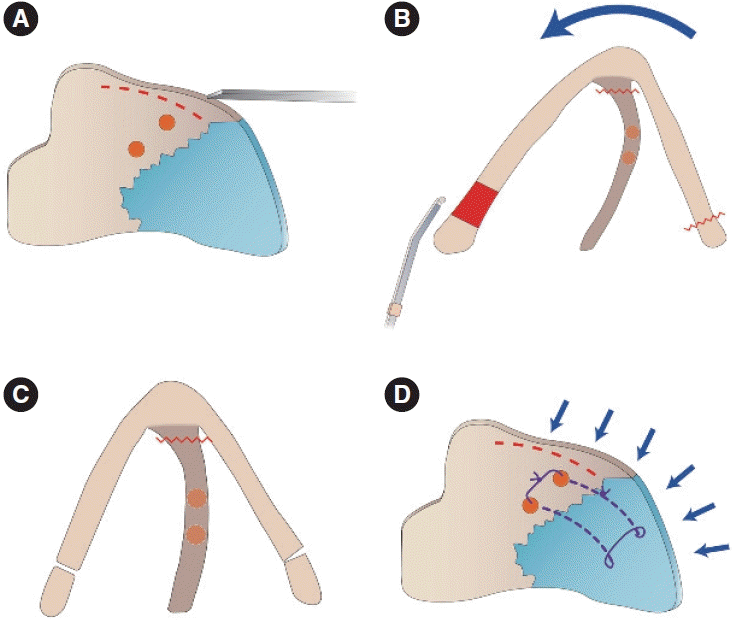

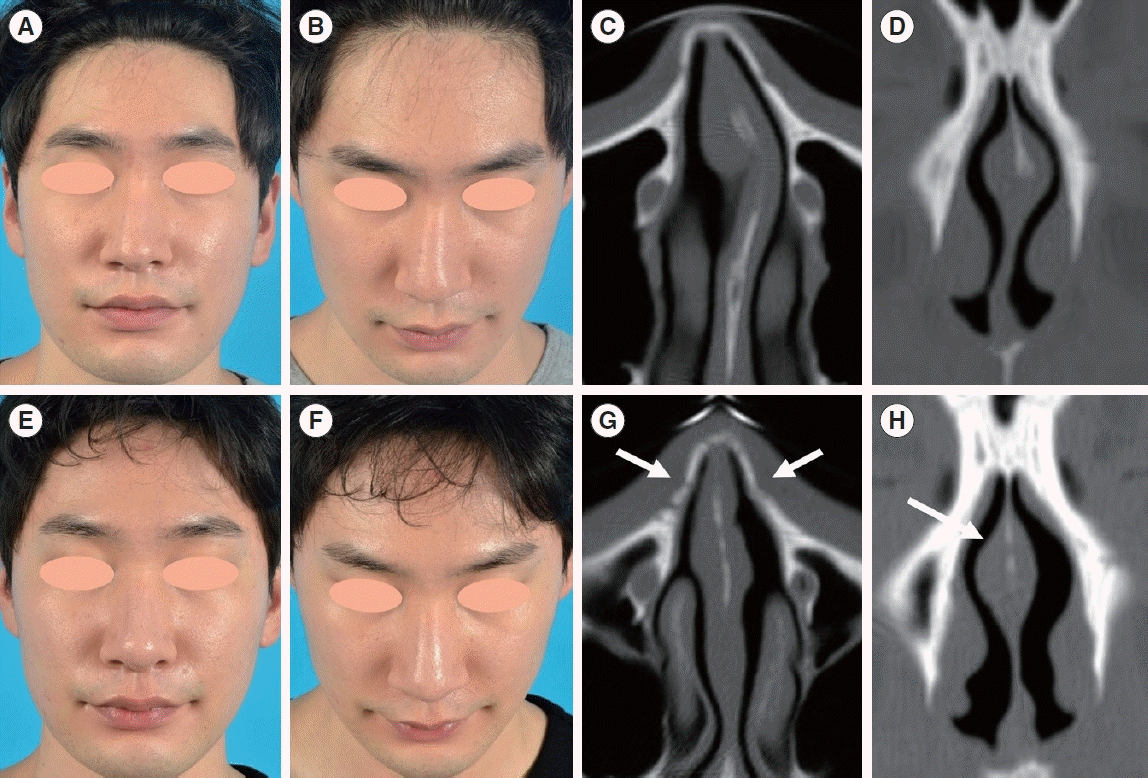
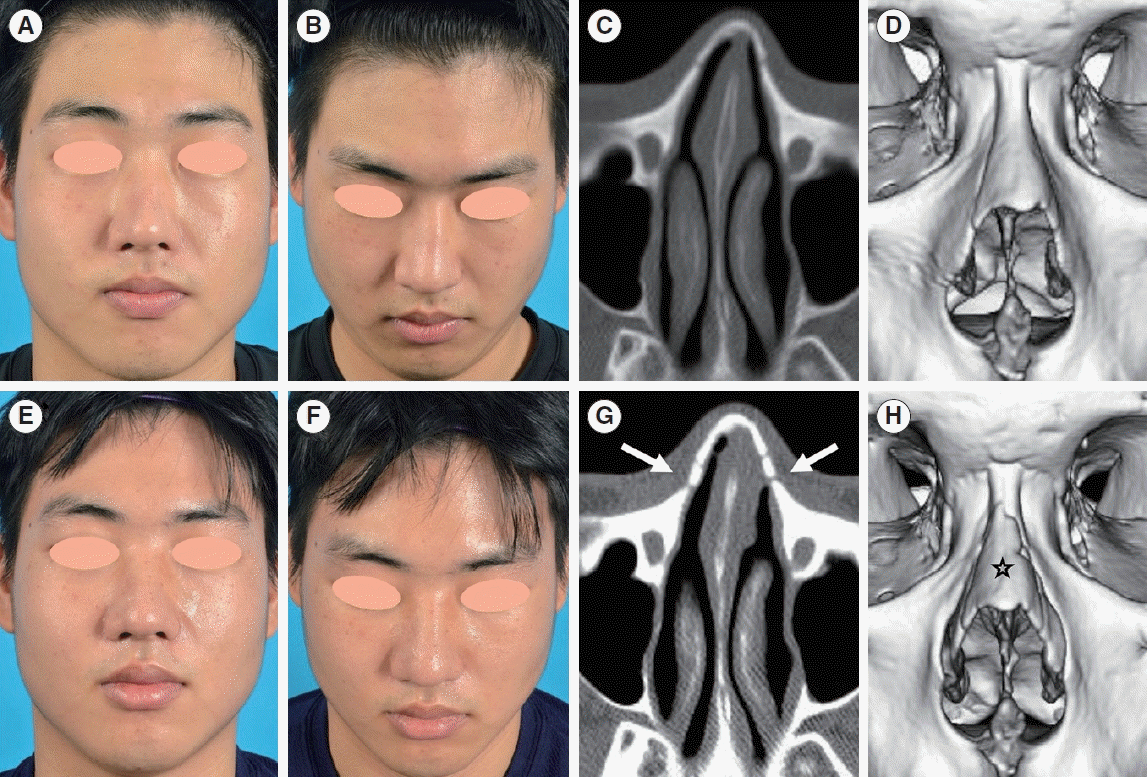





 PDF
PDF Citation
Citation Print
Print



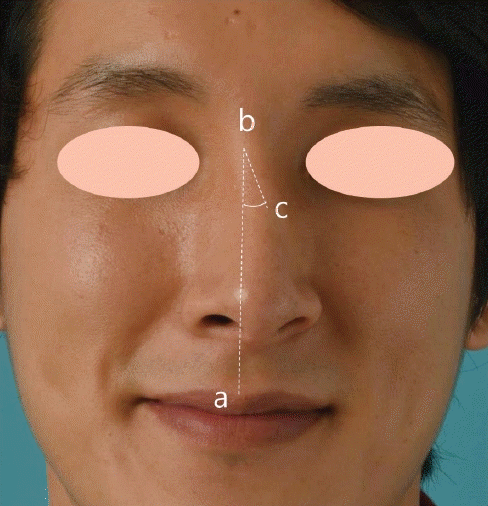
 XML Download
XML Download